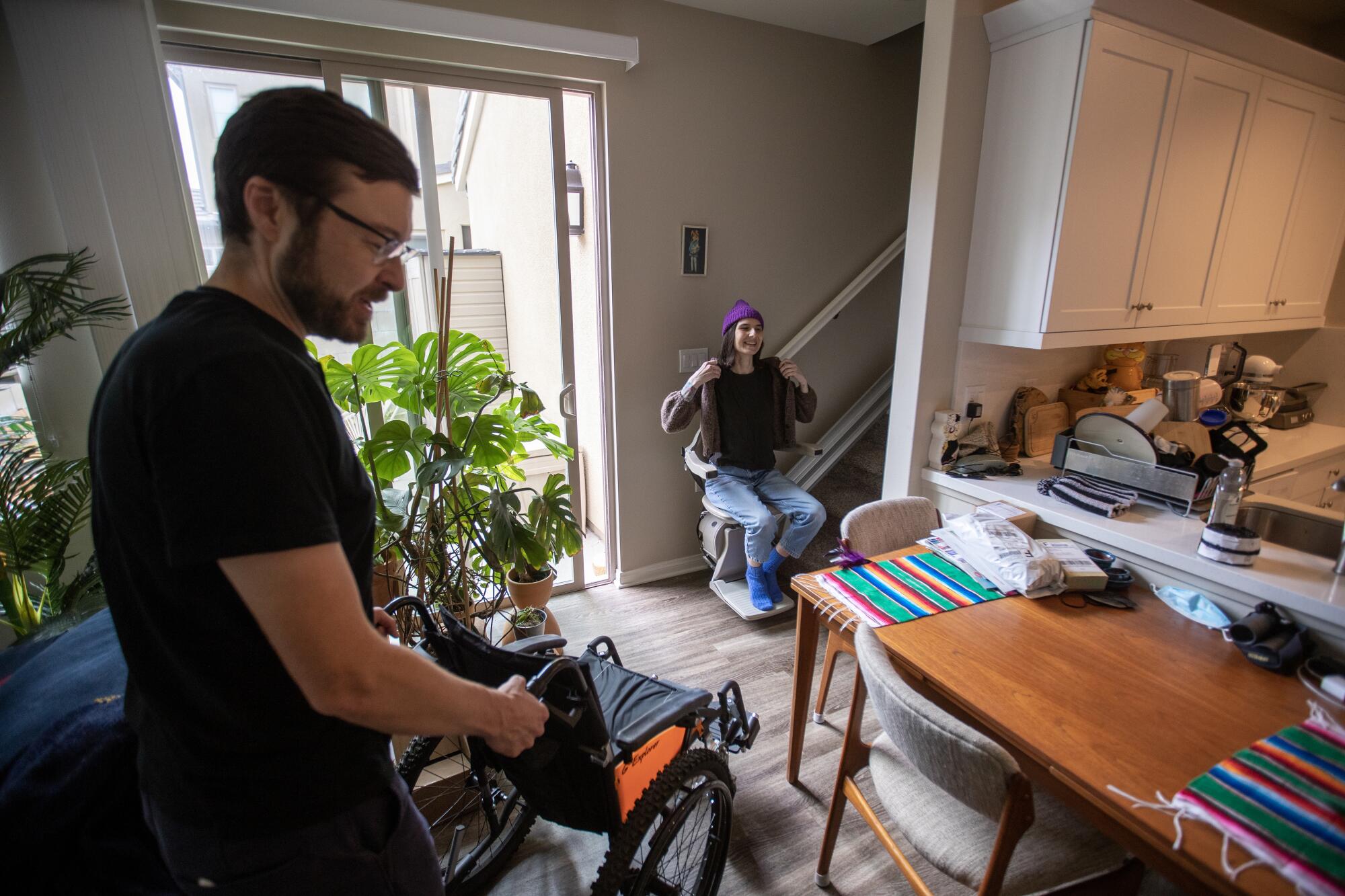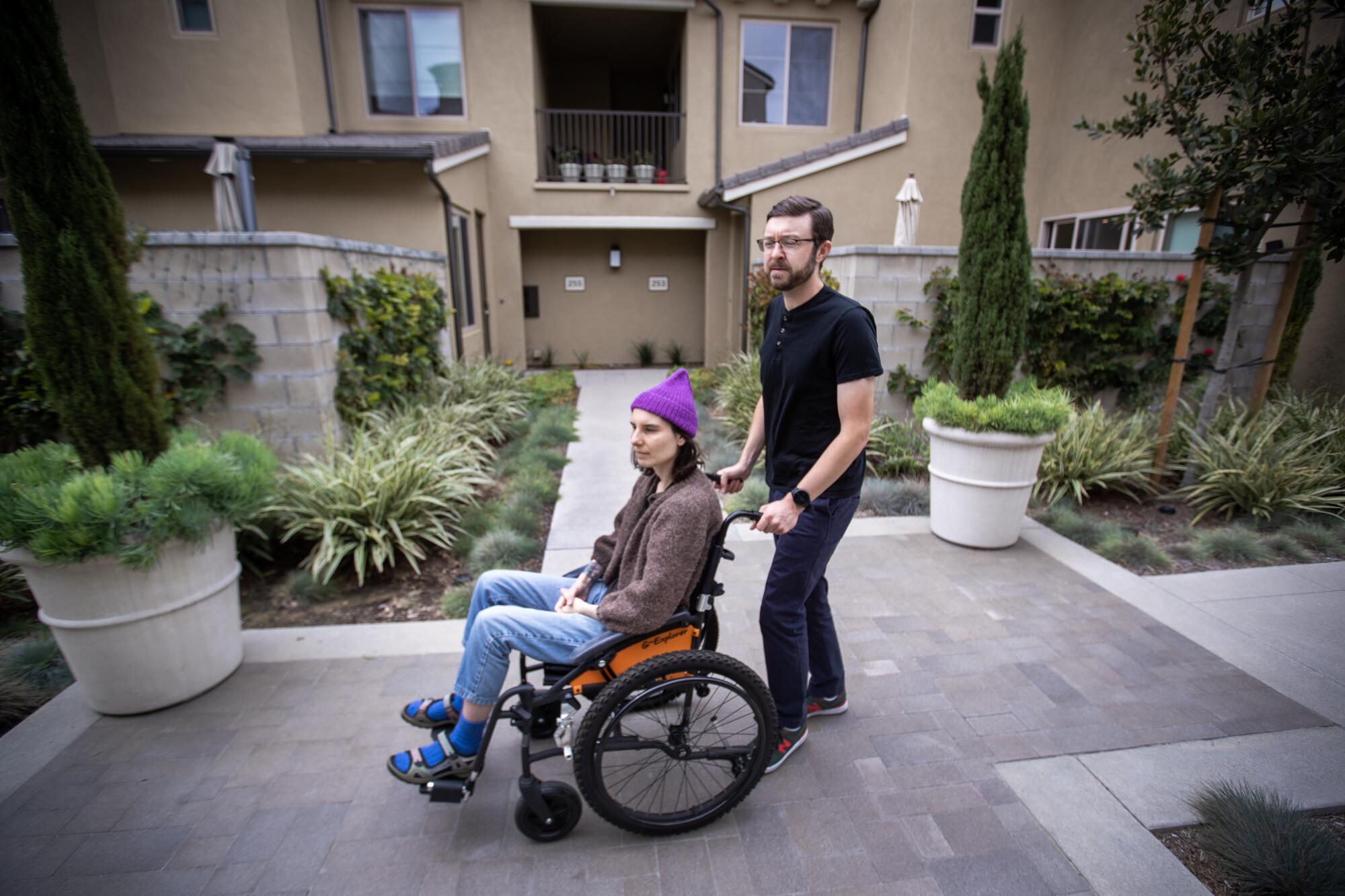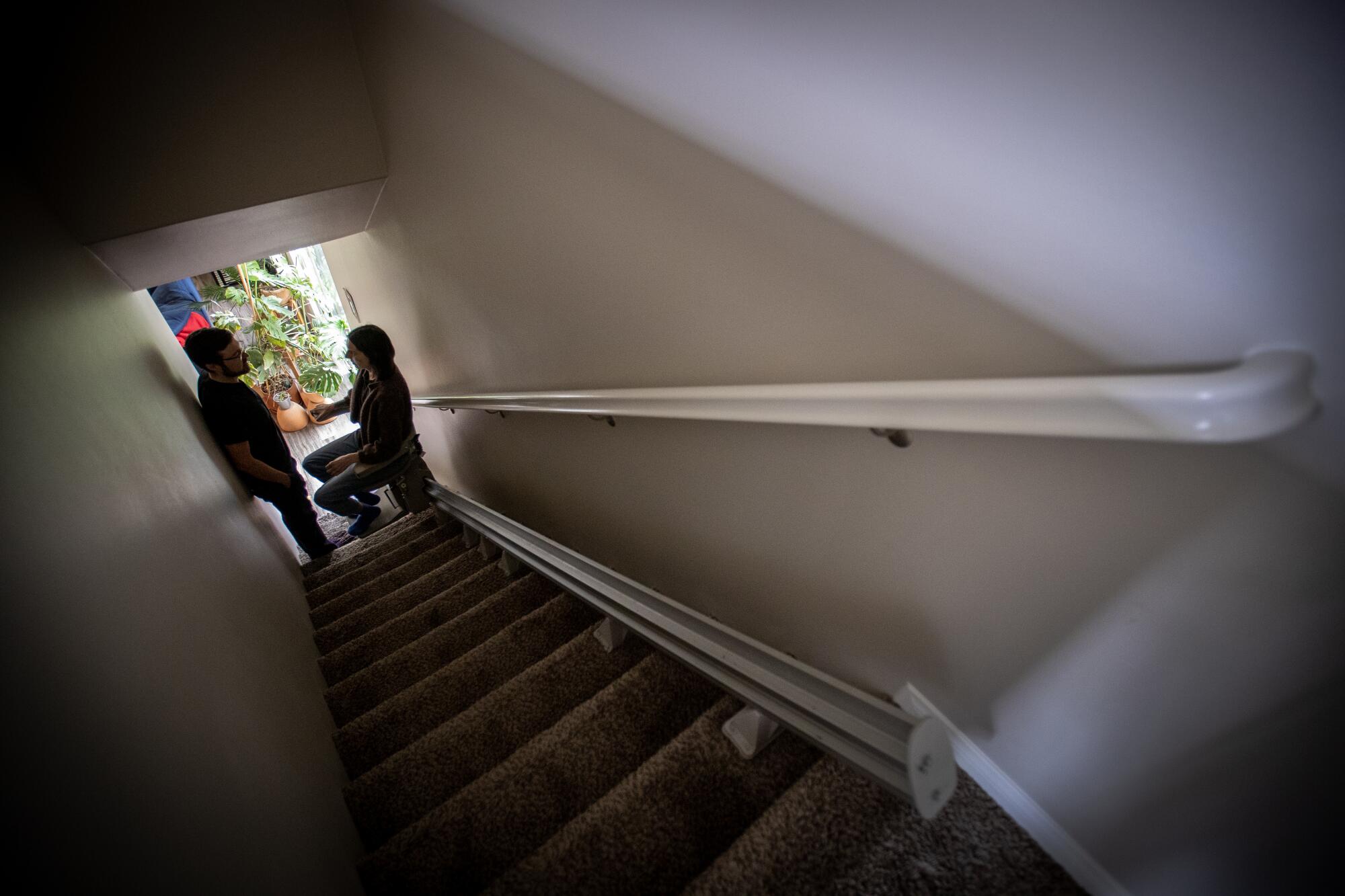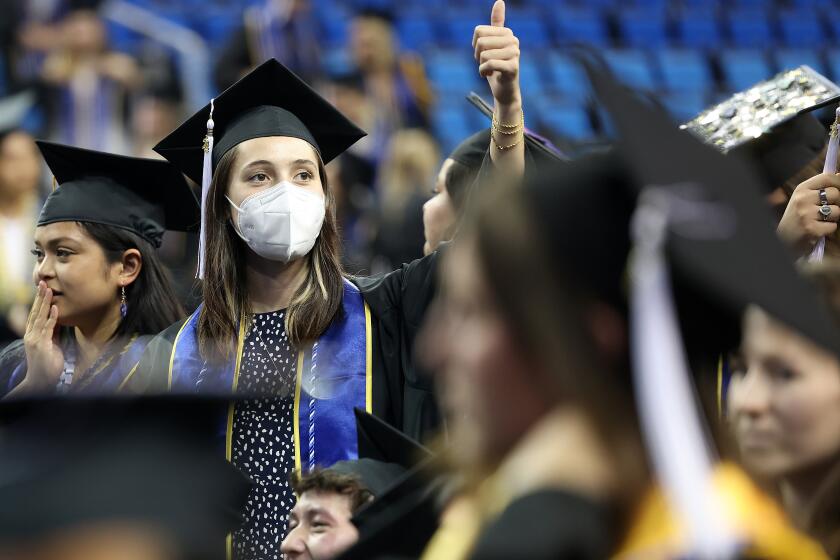
On a Monday morning in Irvine, Courtney Garvin eats her breakfast in bed, it having been set out by her partner before he left for work.
She finishes and heads to the bathroom. She sits down to brush her teeth and wash her face.
From there she takes her longest walk of the day: 25 steps to her unused office, where she lies down in a bed and begins to knit and pet her cat.
At lunchtime she takes a stair lift — a motorized chair affixed to the stairs — down to the kitchen to eat the lunch her partner, Connor Mayer, has prepared. She puts the food in the microwave and sits down again.

Garvin, 37, contracted COVID-19 three years ago and now has long COVID, a condition roughly 15% of California adults report having experienced, according to data collected by the Centers for Disease Control and Prevention. She and Mayer say their world has shrunk. She is no longer able to work.
“I wasn’t expecting to be in a situation like this for another 50 or 60 years, where I lose this much functionality and require full-time care. Chronic illness takes away so many of life’s joys, both big and small,” Garvin said in an email. (Due to the debilitating fatigue, some of the interviews with Garvin were done over email or Mayer spoke on her behalf.)
Most L.A. County residents who had long COVID reported symptoms severe enough to limit daily activities weeks after they were infected, a survey found.
Mayer’s life has completely changed, too.

On mornings when he is working, he wakes up, makes coffee and goes on a run. Then he makes her oatmeal and tea for breakfast, leaving them in thermoses to keep them warm. He also makes her lunch and a smoothie. After making sure she has what she needs, he bikes to work. After 5:30 p.m., he does the dishes and cooks dinner.
She walks about 150 steps daily and goes on a short walk in the neighborhood with Mayer pushing her in a wheelchair, she said.
Garvin and Mayer said they shared their story in the hope of helping other people understand the impact this illness has had on their lives.
“I don’t think anyone expects something like this to happen to them, but here we are,” Mayer said in an email. “When we got COVID in March 2020, we had no sense of the long-term risks associated with it. That sudden loss of independence was tough for both of us.”

Long COVID is the broad term used to describe multiple symptoms that can last weeks or longer after an initial infection with COVID-19. These include blood circulation issues, shortness of breath, neurological issues, gastrointestinal problems and fatigue, among others. The severity of the symptoms, and their impact on people’s daily lives, can vary widely.
Some people see symptoms improve over time, while others have gotten better and then had some symptoms return.
The CDC has allocated $25 million to continue studying long COVID, and groups such as the Patient-led Research Collaborative are working on research on the long-term effects of COVID-19.
While much of the public has begun to move on from the pandemic, people like Garvin are left to deal with the complex medical system and a condition that has no known treatments. Navigating the medical, financial, mental and physical challenges of this illness is challenging.
Before getting sick in March 2020, Garvin worked as a storyboard artist and a touring musician as a member of the Courtneys, and Mayer was in graduate school. Mayer is now an assistant professor in the Department of Language Science at UC Irvine. When he is not working, he is a full-time caregiver for Garvin and limits his social interactions to avoid getting her reinfected.

Garvin stopped working in the fall of 2020 when her fatigue, migraines and shortness of breath made it difficult for her to walk more than a few steps and speak more than a few words.
She went on disability and started seeing doctors, many of whom dismissed symptoms while her health continued to decline. She moved to Irvine during the summer of 2021, where she was diagnosed with long COVID.
“The consistency of the experience of going to doctor after doctor, seeking help, and being disbelieved and condescended to is really surprising to me,” Garvin said. “It points to the underlying systemic issue in our culture where we see chronic illness as a moral failing.”
Besides the mental and physical challenges, Garvin noted that infrastructure issues such as the lack of wheelchair-high counters and a scarcity of automatic doors at doctor’s offices and the Department of Motor Vehicles have made her feel invisible.

The couple live in a townhome provided by UC Irvine that is considered compliant, according to the Americans with Disabilities Act, but the unit’s stairs pose difficulties for Garvin. After several phone calls with the housing authority, letters from doctors and insurance, the couple installed a stair lift, but paid for it out of pocket.
Scientists are exploring whether some of the most infectious coronavirus variants came from chronically infected individuals with weakened immune systems.
Garvin and Mayer have spent roughly $62,000 on medical expenses, including compression garments ($450), the stair lift ($2,750), support groups ($860) and copays ($3,300). They’ve also spent countless hours in waiting rooms, on hold with physicians and dealing with insurance and disability paperwork.
Post-viral illnesses such as long COVID are not new, but some doctors across California are addressing long COVID as a new phenomenon.
“It’s grim to think of how many people’s lives might be changed for the worse because we didn’t understand the long-term effects well enough to factor them into considerations about preventative safety measures,” Mayer said.

Dr. William W. Stringer, a pulmonologist and critical care doctor who started the post-COVID program at Harbor-UCLA Medical Center, is trying to better understand those long-term effects.
“I think there are a lot of people that are unrecognized by specialists and doctors,” said Stringer, who has treated patients with some of the worst long COVID symptoms. “It is also a huge financial problem, between the lack of social work and assistance for food and trips to the doctor.”
Mayer said it’s frustrating for him to see a serious health issue have low public awareness and sympathy. Toward the end of the interview, Garvin said she was exhausted and had Mayer speak on her behalf.
“Strength is something I feel pretty short on at this point,” she said. “I’m completely worn out.”
Do you have long COVID in California?
The Los Angeles Times is working on a series of stories to understand the experiences of long haul COVID-19 patients and their caregivers. You can contact The Times here.
More to Read
Start your day right
Sign up for Essential California for news, features and recommendations from the L.A. Times and beyond in your inbox six days a week.
You may occasionally receive promotional content from the Los Angeles Times.










